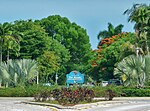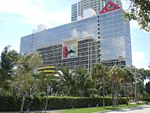Vizcaya station
1984 establishments in FloridaGreen Line (Metrorail)Metrorail (Miami-Dade County) stations in MiamiOrange Line (Metrorail)Railway stations in the United States opened in 1984

Vizcaya station is a station on the Metrorail rapid transit service station in The Roads neighborhood of Miami, Florida. The station is located near the intersection of Southwest First Avenue and 32nd Road, at the southern terminus of I-95 at South Dixie Highway (US 1) two blocks southeast of Coral Way. The Vizcaya station opened May 20, 1984 and features a pedestrian bridge over the US 1/I-95 junction for access to the Vizcaya Museum and Gardens and residences east of the highway.
Excerpt from the Wikipedia article Vizcaya station (License: CC BY-SA 3.0, Authors, Images).Vizcaya station
Southwest 1st Avenue, Miami
Geographical coordinates (GPS) Address Nearby Places Show on map
Geographical coordinates (GPS)
| Latitude | Longitude |
|---|---|
| N 25.749722222222 ° | E -80.211666666667 ° |
Address
Southwest 1st Avenue 3201
33129 Miami
Florida, United States
Open on Google Maps








